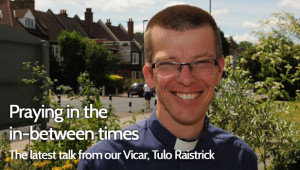Luke 24:1-12
Easter Sunday
St Barbara’s; 20.04.2025
Rev Jeremy Bevan
A few years ago, my work as a civil servant plunged me into the adrenaline-fuelled world of emergency planning exercises. We were testing out how we’d keep the country running if a crisis like Brexit or a pandemic upended everything we knew about way the world worked.
It was demanding, but it served a purpose. Stress shuts down the parts of our brain responsible for fresh, innovative thinking. Frazzled people tend to revert to familiar patterns: they can’t find new ways of doing things, new ways to be, when they need them most. If you’ve practised under stress – so the theory goes – you’re more likely to respond well in a real crisis.
The women at the tomb are clearly under stress. They’ve seen their great hope, Jesus, condemned by two unfair trials; mocked and reviled by crowds that had cheered him a week earlier; humiliated and brutally murdered. The one who was to upend everything and usher in God’s new reality is now – their frazzled minds believe – dead in a stone-cold tomb.
That’s where we meet them as our gospel reading begins in the dark pre-dawn depths of that first day of the week. With the spices they’ve prepared, they’re off (they believe) to anoint Jesus’ dead body in the tomb where they saw his dead body laid three days earlier. But Luke’s extraordinary account of the women’s discovery of the empty tomb offers us at least three challenges.
Firstly, the challenge of staying faithful. Twice during his account of the crucifixion and burial of Jesus, Luke refers to ‘the women who had followed him from Galilee’. Earlier in Luke’s gospel (chapter 8), we learn that this large group provided for Jesus and the disciples from their own resources during his earthly ministry. They persist with Jesus to the end, watching, enduring all that happens to him on the cross. And risking the dangers of a still-dark night as they make their way to the tomb, they go on keeping faith as far as they can.
A group, like these women, like a church congregation, can encourage, support and ‘carry’ one another when things are tough. We learn and grow together. For the women, it’s enough. It gets them as far as the tomb, together.
Right now, approaching the tomb with the women in our turbulent world, is Jesus dead or alive for you? Is the stress of simply keeping going, keeping it all together, blocking out the truth that he’s alive? If so, who here (or among Christians you know) might you ask to help you gain fresh insight, help you go forward with the living one who is risen?
Faith needs God’s help to go forward, too. The women at the tomb need God’s help to see, and to risk embracing, the fresh realities of the post-resurrection world. Here’s a second thing Luke commends about the women, then: a willingness to risk, to respond. Speechless as they are at having discovered the empty tomb, God appears among them in the form of the two messengers. They ask the women, “Why are you looking for the living among the dead? He is not here, but has risen.”
I don’t think we’re meant to hear those words as scolding or rebuking. Rather, they’re a gentle calling back to a deeper reality the women do know, but one that the stress of recent days has buried. And to their credit, though terrified, they stand their ground; take time to do what the messengers tell them; and “remember” how Jesus predicted his death and resurrection.
Are we open today to God’s prompting to take stock again of Jesus this Easter, to go on responding to the truth of who he is, to remember the implications for us of all he said and did? It’s a risk, of course it is. It could change us in all sorts of ways, take our lives in directions we might scarcely be able to imagine. Are we up for that risk, as the women at the tomb were?
What happens when they “remembered his words”? Well, they’re galvanised. After the slow build-up to the moment of “remembering”, suddenly the women are off, telling all that they’ve experienced to the disciples and the wider group of Jesus’s followers. Here’s a third thing, then, about this group of women that Luke commends to us: their enthusiastic embrace of the new and changed world.
They tell what they’ve seen. The Greek verbs in the original make clear that they tell it repeatedly, to the disciples and many others. Perhaps the named women (the two Marys, and Joanna) are named because they became mainstays of the early church, known and revered for the witness their lives gave, their embrace of the amazing truths of a changed, post-resurrection world? Sadly for Peter, that witness is “nonsense”, or in some translations an “idle tale”, until he too peers into the empty tomb and begins to embrace for himself that new world where everything begins again. Nonsense, idle tale, or credible witness? The choice is ours.
The women’s faithfulness, and God’s prompting, gets them to a place where the overwhelming reality that Jesus is (not dead but) “living” breaks over them like an exhilarating wave and carries them forward onto a fresh shore. It re-shapes their lives and the lives of those they tell of the empty tomb, as they seek to align their lives more and more with how God wants them to live. In ways that are life-enhancing, bringing the wholeness, and the healing, that Jesus gives.
Will that be our story this Easter Sunday? Wherever our faith is today, God is ready to meet us, prompt us, galvanise us to follow more passionately after the living one, who is not dead, but has risen. And to be changed by him as we ride that Easter wave. Amen.

